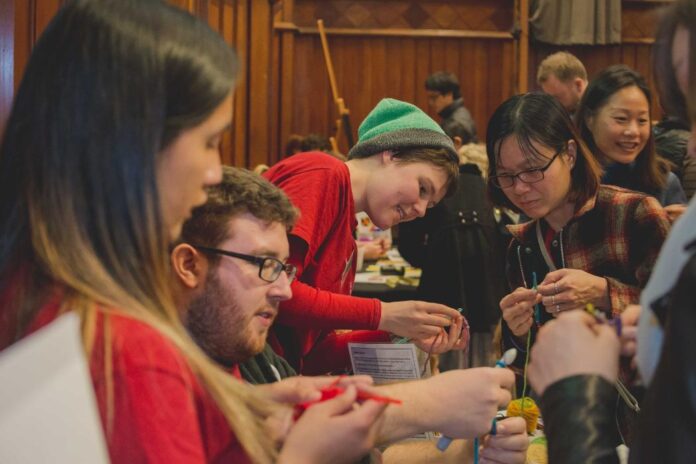Source: University of Canterbury
07 May 2021
Chaos theory and crochet collide in Christchurch this month. University of Canterbury mathematicians are playfully promoting the art and craft of mathematics through a free public event on Sunday, 23 May. The Christchurch Maths Craft Day is free and open to everyone: experts and amateurs, maths-fans and maths-phobes, the crafty and the curious.
-
University of Canterbury mathematicians are playfully promoting the art and craft of mathematics through a free public event on Sunday 23 May.
“Maths is often overlooked as a subject of beauty and imagination,” says Senior Lecturer and Maths Craft co-creator Dr Jeanette McLeod of the University of Canterbury (UC) School of Mathematics and Statistics.
A pure mathematician and a Principal Investigator of Te Pūnaha Matatini, Dr McLeod has a passion for sharing the creative, playful side of mathematics.
“Because I do craft, I see the beautiful maths in it,” she says. “I meet these amazing knitters who created amazingly complex patterns, but say ‘oh, I can’t do maths!’ when really they’re thinking mathematically all the time.”
Maths Craft New Zealand is a national initiative cofounded and run by University of Canterbury mathematicians Dr McLeod and Dr Phil Wilson, dedicated to bringing maths to the masses through craft.
Featuring a range of craft creation stations and public talks by mathematician crafters, the day-long celebration of maths engages people of all ages.
Learn to knit a mathematical knot, crochet a Möbius strip, fold an origami octahedron, and flex a hexahexaflexagon. UC student volunteers with backgrounds in maths and crafting will answer questions and help people with their crafty creations.
Ancient antiquities exhibition
The University of Canterbury’s Teece Museum of Classical Antiquities, in UC Arts’ Old Chemistry building at the Arts Centre, will also be open for the public to discover the ancient relationship between maths and art. Enjoy the Teece Museum’s Myths and Mortals exhibition and learn about the mathematics behind ancient Greek meander patterns.
Free expert talks
Expert speakers will present a series of maths- and craft-themed talks throughout the day, ranging in topics from fractals and pleating to crochet and chaos. The following talks will be held in the Recital Room in UC Arts’ Recital Room (Old Chemistry building, Arts Centre):
11am: Four Colours are Enough – Dr Jeanette McLeod, University of Canterbury
How many colours are needed to colour a map so that no two regions sharing a border are coloured with the same colour? What if you had to use the fewest colours possible? Mathematicians took over 100 years to find the answer, and the result is one of the most controversial theorems of the 20th century! In this talk Dr McLeod will discuss the history of the infamous Four Colour Theorem, explain why mathematicians struggled with it so much, and explore its links with crafts such as knitting, quilting, and colouring.
1pm: Zigzags, Fractals, and Pleating – Dr Michael Langton, University of Canterbury
Pleating fabric is a mathematically fascinating and historically fashionable craft involving folded patterns that often look like zigzags. Everyone understands zigzags, but how do you make folding zigzags efficient? What happens if the zigs and zags don’t alternate perfectly? What happens if you do infinitely many of them? How do you fold a two-dimensional zigzag? What even is a two-dimensional zigzag? How many different fold patterns are possible? Exploring the answers to these questions Dr Langton will take us through papercraft, fractals, and the mechanics of pleating fabric.
3pm: Chaos in Crochet and Steel – Bernd Krauskopf & Hinke Osinga, University of Auckland
Bernd Krauskopf and Hinke Osinga are professors in Applied Mathematics who study how chaotic behaviour arises and can be explained mathematically. Their research led them into craft and art when they realised they could turn their computer-generated images of the famous chaotic Lorenz weather model into a physical model via crochet. The so-called Lorenz manifold embodies the underlying unpredictability in an intriguing and hands-on way. With over 25,000 stitches, the metre-wide crocheted piece has gained worldwide media attention. The amazing mathematical properties of the Lorenz manifold also intrigued artist Benjamin Storch, who turned it into a steel sculpture. Professors Krauskopf and Osinga will highlight some of the underlying geometry and their journey from maths into craft and art.
Discover the maths behind craft and the craft behind maths with the return of the Christchurch Maths Craft Day 10am – 5pm on Sunday 23 May in The Great Hall & UC’s Old Chemistry building, both at The Arts Centre, 2 Worcester Blvd, Christchurch. Free entry, www.mathscraftnz.org.



